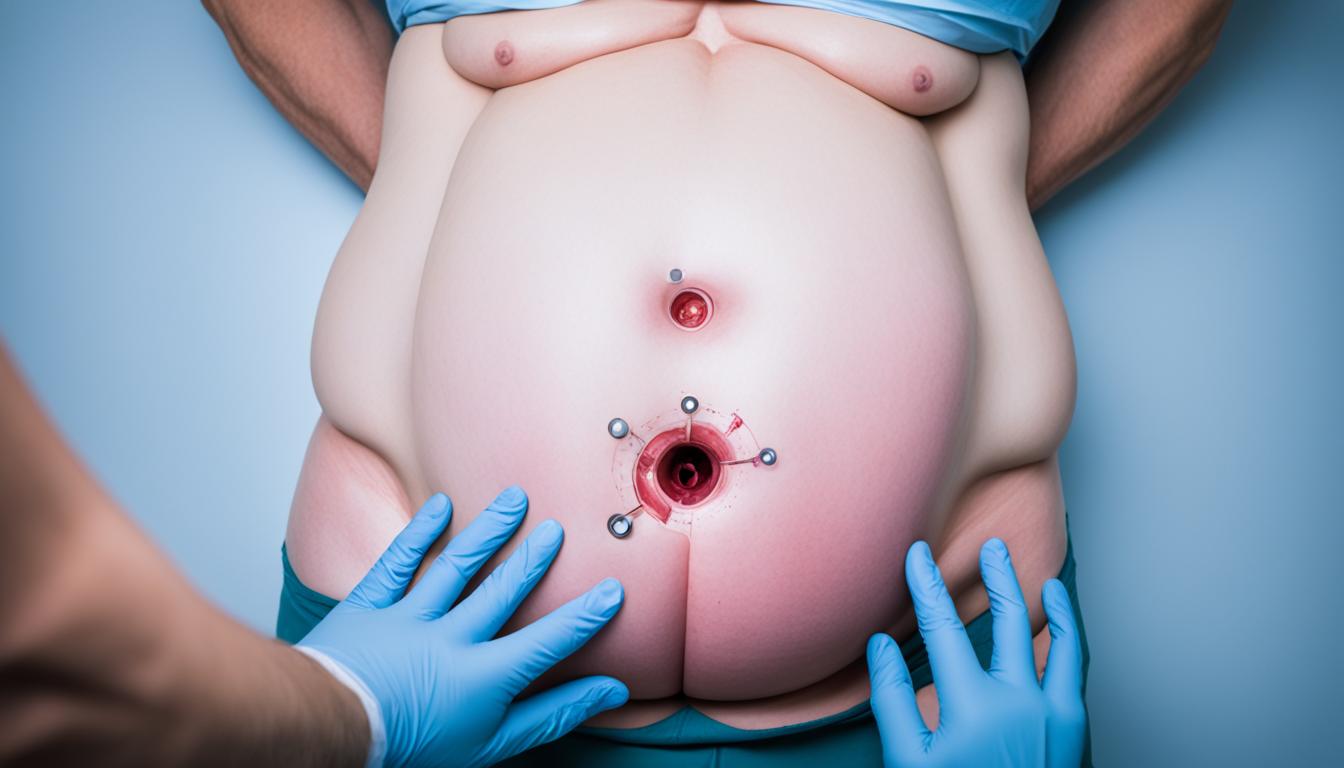Umbilical hernia is a common birth defect in babies. It is marked by a bulge in the navel area. This bulge happens when organs in the abdomen push out.
This condition often affects premature or low birth weight babies. As many as 75% of babies under 1.5 kg can have it. Luckily, most of the time, the hernia goes away by their first birthday. If it doesn’t close by age 4, a doctor might recommend surgery.
The main cause is the opening in the abdominal wall where the umbilical cord passes through. This spot doesn’t fully close in some babies. As they grow, usually, the opening closes, and the hernia goes away. But sometimes, surgery is needed to fix it.
For babies with an umbilical hernia, you might see a small, soft lump at their belly button. It might get bigger when they cry or cough. Most of these hernias are not painful. However, they could lead to serious problems, like bowel strangulation, which needs immediate medical care.
The treatment depends on the hernia’s size and if it’s painful. Sometimes, the doctor might wait and see if it gets better. But if surgery is needed, the process is usually simple. Surgeons make a small cut near the hernia, push the bulge back in, and close the wall. They might use a mesh for support.
Key Takeaways:
- Umbilical hernia is a common birth defect characterized by a bulge in the navel area.
- It is most common in premature or low birth weight infants.
- Most umbilical hernias resolve on their own by the age of 1.
- Surgery may be necessary if the hernia does not close on its own by the age of 4.
- Causes of umbilical hernia include incomplete closure of the abdominal wall muscles at the site where the umbilical cord passes through.
- Symptoms include a soft tumor protruding from the navel that becomes more prominent with activities such as coughing or crying.
- Treatment options include watchful waiting for mild cases and surgery for larger or painful hernias.
Causes and Risk Factors of Umbilical Hernia
Umbilical hernias form in babies when muscles don’t fully close at their belly button. This allows some part of their intestines to poke through, making a lump. Several things can lead to this issue, though.
- Prematurity: Babies born early are at a higher risk because their muscles are not fully grown.
- Low Birth Weight: Small babies face a larger chance as their muscles might not be fully developed.
- Gender: Baby girls might develop these hernias more than baby boys.
- Congenital Conditions: Sometimes, babies are born with weak belly muscles, causing hernias. This is due to health issues they might have from birth.
Some people are more likely to get umbilical hernias. This is due to different things like being born early, growing older, or having health habits like coughing a lot, or not being able to go to the bathroom easily. Being heavy or having family members with hernias also plays a part in this problem.
However, hernias can also just happen without a clear reason or factor, too.
To know more about what causes and leads to umbilical hernias, look at the table below:
| Causes | Risk Factors |
|---|---|
| Incomplete closure of abdominal wall muscles | Prematurity |
| Low birth weight | |
| Female gender | |
| Congenital conditions | |
| Premature birth | |
| Advancing age | |
| Chronic coughing | |
| Chronic constipation | |
| Overweight or obesity | |
| Personal or family history of hernias |
Symptoms and Diagnosis of Umbilical Hernia
An umbilical hernia shows as a bulge or lump near the belly button. This lump gets bigger when the baby coughs or cries. It might go away when the baby is calm or lying down. Other signs include a big tummy, tummy ache, throwing up, and troubles using the bathroom.
Many times, umbilical hernias in babies don’t cause any problems. They are found during a checkup. Parents should watch for any changes and see a doctor if they’re worried.
The doctor diagnoses an umbilical hernia by checking the belly button. They might push on the bulge softly to see if it goes back in. Sometimes, they’ll use a special test like an ultrasound to know more.
If you think your baby has an umbilical hernia, see a doctor. Finding it early and getting the right care is essential. It helps keep the child safe and healthy.
Treatment Options for Umbilical Hernia
Most babies born with an umbilical hernia don’t need surgery. The hernia often gets better as they grow. But, if the hernia is big, painful, or lasts past age 4, surgery might be suggested.
Surgery for this type of hernia is simple and safe. It starts with a small cut close to the hernia. Then, the bulging tissue is put back where it should be. The surgeon strengthens the belly wall. They might also put in a mesh to stop the hernia from coming back. This method reduces surgery time and speeds up recovery.
If surgery isn’t needed right away, doctors just keep an eye on the hernia. They look for any changes or problems that might need attention. For discomfort or pain, there are ways to help without surgery.

